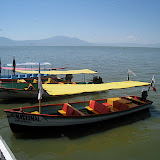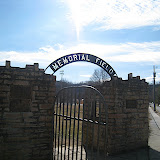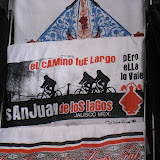On the bus to
Lagos de Moreno Chris kept poking my arm to wake me up and point out the window.
There! A line of pilgrims walked along the side of the road…
There! A temporary makeshift campground of tents and food stands was set up next to the highway…
There! A truck with a wildly-decorated replica of San Juan’s cathedral strapped onto it, San Juanita herself clearly visible inside the wooden replica…
We arrived in Lagos de Moreno just before dark. I wanted to pull out my trusty
Lonely Planet guidebook to see a map of the town, find a bus that would take us to the center of town, that sort of thing. But there was no map, because there is no entry for Lagos de Moreno in our guidebook. We took a taxi from the bus station to our hotel, then wandered out to choose one of the many unknown restaurants for food. Before going to bed, we gazed up at the massive, towering central church, larger and taller than even the cathedral in Guadalajara, and much, much too large for this town. I felt a feeling rivaling that of our first few days in Mexico, as if we had left familiarity and entered a foreign country again.
It had finally happened. We had left the tourist route. We were off the map. We were beyond the Lonely Planet.
***
The next morning we woke to hustle and bustle outside our window. This is a busy weekend for Lagos (Lagos, I’ve learned, is what everyone around here calls Lagos de Moreno), the time when pilgrims to nearby
San Juan de Los Lagos come through in droves. Chris poked her head out our window, and looked out: A whole caravan of bicyclers, maybe 40 cyclists in all, had gathered in the central square to prepare for their ride to San Juan (and San Juan, I’ve learned, is what everyone around here calls San Juan de los Lagos). They wore identical cycling jerseys, red-white-and-green, that had an image of the
Nuestra Señora de Juan de Los Lagos on it, the name of their church and where they were from, and in large block letters “1953-2003: 50th Peregrinacion.”
As the bikers prepared to finish their parish’s 56th
pilgrimage from the state of
Hidalgo (near Mexico City, some nine hours away by bus and who knows how long by bicycle) to San Juan de Los Lagos, we breakfast and asked the hotel receptionist for walking directions to the bus station. We’re staying in a business hotel, rather fancy for us, but it was the only one Chris could find online, so we went with it. It’s a curious thing: Just because Lagos de Moreno is not in the guidebook doesn’t mean it lacks for luxury goods. It’s a remote, dusty town without a
Sanborns, but turn a corner and you might find a little boutique clothing shop or a Domino’s Pizza. It’s a wild mix of old (the enormous central church, built in the 1700s) and modern (lots of pizza places), rich (luxury business hotels) and poor (thin, sun-beaten elderly women huddled outside the church doors with outstretched arms and open hands), a rural image of Mexico to match Mexico City’s urban one.
We walked through town, surprised by more than one lush green city park, and found our way to the bus station. We bought a ticket for the half-hour ride to San Juan de Los Lagos and boarded the bus, which was so full we had to stand and hold onto the railing. Once on the road we watched as bikers passed us, some from the group we had seen earlier, others in groups from different places through Mexico, all wearing matching jerseys of blue or red or green. We passed large groups of people walking along the side of the road together, carrying a giant shadowbox of the Virgen de San Juan de Los Lagos in front of them, flags and balloons behind, and maybe a large crucifix somewhere in the midst of them. Once we saw a group of men and boys in indigenous headdresses, dancing in circles and drumming as they led their group along the road. Food-and-drink stands were set up, usually in clumps together at strategic points along the journey.
After forty-five minutes of what was supposed to be a half-hour ride, we came to a place with more food tents and market stands than we had seen anywhere else, and several people got up to get off the bus. So we got up, too, and left the bus, not bothering to ask anyone if we were in or even near San Juan. We just kind of thought we must be there; we had our doubts, but then we were probably pulled the rest of the way out by the mesmerizing scene outside our window. So we left the bus.
We wandered through the dusty market, noticing what was for sale – everything from fresh socks for tired feet to chicken grilling right under our noses – and watching the people. We saw a bridge over the road and made our way for it, thinking we’d have a great view of the pilgrimages making their way down the road. And we did. It was an amazing sight, the highway lined with pilgrims walking and biking their way along the 45 kilometer (about 30 miles) road from Lagos to San Juan in the hot sun.
And then, suddenly, it dawned on us: Outside of this bustling roadside market, there was no town anywhere in sight. We left the bridge and not far down the road we found a green road sign: SAN JUAN DE LOS LAGOS 20 KM.
Our bus was long gone. We remembered what we heard about how long it took pilgrims to make the trip on foot: about 9 hours. Of course, those people usually made the trip at night, when it was cooler. We, on the other hand, had an unexpected 4-hour walk ahead of us along this hot and dusty highway. So we did the only thing we could do: We joined the pilgrimage.
Before long the cyclists we had passed while on the bus passed us. Trucks passed by coming back from San Juan, and beeped us, waving and hollering, and we waved back. Every once in a while a blue semi would pass full, absolutely full, of squealing pigs, who left a lovely scent in their wake.
Intent on arriving in San Juan before dark, we walked more quickly than most everyone else (typical Americans, always in a hurry). We passed small families with children walking between them, and then whole congregations with their own traffic guard assigned to them. Most everyone had wide-brimmed hats or bandanas covering their necks, protecting themselves from the fiery red skin that I now have. Some people carried flowers they planned to give the
virgen when they arrived. At least one woman walked along the hot asphalt
descalzo – barefoot.
From our angle here on the ground we could see everything better. In places where the groups of people thinned out we gazed out over the rural landscape of Los Altos – “The Highlands,” the name for this area of northern Jalisco. There were lots of cows, the primary livestock of the region (surprising, given the number of hog-trucks we saw on the highway). As for the land, it was painted with lots of shades of brown; green space was scarce. This was the dry season, and the land here isn’t very arable anyway. But of course even here there is plant life that finds a way to survive:
maguey and cacti and plenty of other strange plants that botanists could tell you about better than I.
After a while the market stands disappear but the food and drink don’t. Like water stands at a 5K run, people – usually church groups identified by identical t-shirts – stand along the side of the road and hand out cups of water and whole oranges. After you’ve been walking in the hot sun for hours, little tastes better than sucking on half a fresh orange.
Finally we begin to see the first signs of the city, first junkyards and warehouses, then fancy auto dealerships and hotels, all with “SAN JUAN DE LOS LAGOS” painted into their names. We walk further and further into town, until, almost suddenly, the streets become madly crowded with market stalls selling t-shirts and just-arrived pilgrims going in all directions. We wind our way around the corners and into the gates of the church courtyard. The Basilica of San Juan de Los Lagos is like something out of another world; it towers over the rest of the town like a lone mountain towering over molehills.
We walk in, and immediately the people next to us drop to their knees, and begin shuffling towards the altar. There are pews, but they line the sides of the church; the center aisle is wide and open for the pilgrims to make their way forward in whatever way they see fit. As we enter, the church is packed, and mass is beginning with its penitential opening: “
…por mi culpa, por mi culpa, por mi gravisima culpa…”
Making our way to the front, we move off toward a side room that Chris remembers from her last visit here in 2006. It is a multilevel space with walls covered in items left by pilgrims for the virgen in thanksgiving for miracles received. There are baseball hats and bike helmets that must have been worn on the journey, an actual bike propped up against the wall, three white wedding dresses hanging high up, acoustic guitars and mariachi hats, long braids of brown hair tied up in bows and pinned to the wall, report cards and graduation certificates in frames, an official photo of a young man in an U.S. Army uniform (someone’s son?), and of course, the famous
retablo paintings, some made traditionally by hand and painted on tin, others printed our on white paper, made with Photoshop and clip-art. Every item has a note attached explaining the miracle performed by the Nuestra Señora de San Juan de Los Lagos and offering her thanks. It is overwhelming.
From there, what is left of the day seems like a tired blur. We sit down at the first place we see to eat food. We find our way to the bus station and buy a ticket back to Lagos de Moreno. The bus system is confusing, and it seems like a long time before we can finally board a bus back to Lagos. But we do. It is dark by the time we are on the road, and on the way back we can see the lights of campfires as we pass the groups of pilgrims stopping for the night. Back in Lagos, the dried-up riverbed is full of its own camps, and they are wide awake: live music pours out of the darkness as we pass.
On our way back to our hotel, we tell the taxi driver about our day, unintentionally joining the pilgrimage and walking half of the distance between Lagos and San Juan.
We walked 20 kilometers! Chris tells him.
“Hmm,” he nods, unimpressed. “You missed 30 of them.”



















